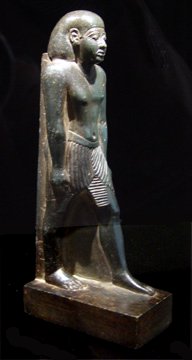Unquiet Pe-shery-aset

| |
| The statue of Pe-shery-aset finally comes to rest in the Genoa Museum. |
Ancient Egyptians, concerned for their well-being in the afterlife, commonly erected statues of themselves in their tombs which could serve as substitute bodies if anything should happen to their embalmed corpses. Chephren, builder of the second-largest pyramid at Gizeh, took this to extravagent lengths, putting a dozen or so statues of himself in his mortuary temple and burying a final one in a pit beneath the floor. (His precautions proved wise: the dozen or so have disappeared and only the buried one remains, which means that Chephren's ka now resides in the Cairo Museum!)
Pe-shery-aset, a priest at Edfu in the 7th century BC, provided just such a statue for himself, carved out of black steatite. When his tomb was found - we presume by robbers, for its location is not known - Pe-shery-aset was ignominiously hauled out of his House of Eternity, complete with statue and sarcophagus, and sold to Tigrane Pasha, a wealthy Armenian who lived in Cairo in the 19th century.
When Tigrane Pasha, in his turn, went to join his ancestors, most of his collection of antiques was bought by Michel Abemayor, a dealer in antiques. Pe-shery-aset and his funerary equipment travelled across the Atlantic to New York when Abemayor moved there to open a shop in Madison Avenue. From then on things become more confused.
We know that Gaston Maspero, the famous Egyptologist and director of the Cairo Museum, owned Pe-shery-aset's statue at one time, as he had his name carved on the back. We also know that the statue was displayed in the Brooklyn Museum as part of a temporary exhibition in 1960, but that is all. Where it was in between we simply do not know.
Pe-shery-aset's mummy and sarcophagus have a better attested fate, for they ended up in the Archaeology Museum of Genoa! It is thought that Antonio Figari, an Italian who introduced the modern pharmacy to Egypt, purchased them - possibly from Tigrane Pasha. They were presented to the museum in 1931 by one of his descendants, Emanuele Figari.
Now the Edoardo Garrone Foundation, which purchased the statue at Sotheby's in 2004, has given it to the Genoa Museum on long-term loan. Whether Pe-shery-aset's ka breathed a sigh of relief at having the statue back is not known; somehow I doubt it, as the staff of the Genoa Museum are not known for their punctiliousness in providing regular food offerings. Pe-shery-aset is probably having to make do with discarded pieces of pizza and half-drunk cups of coffee from the museum cafe.





